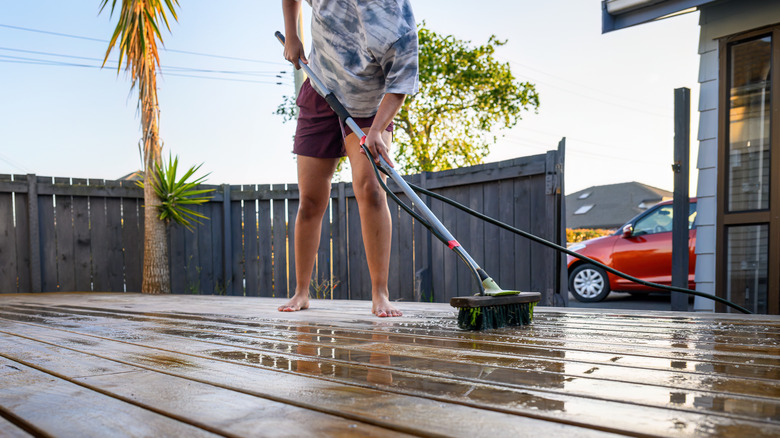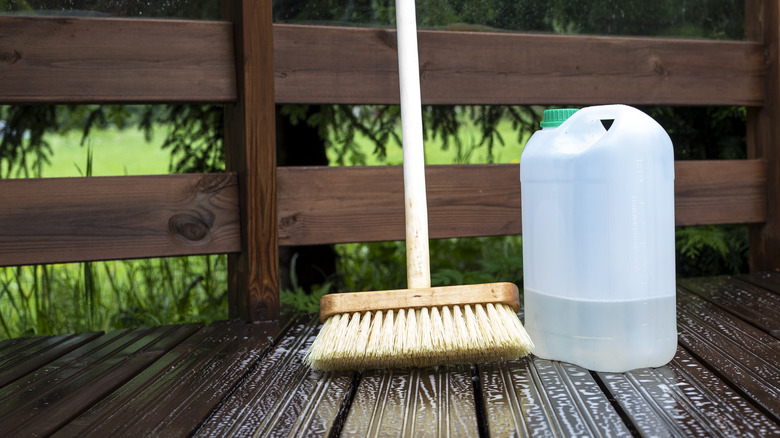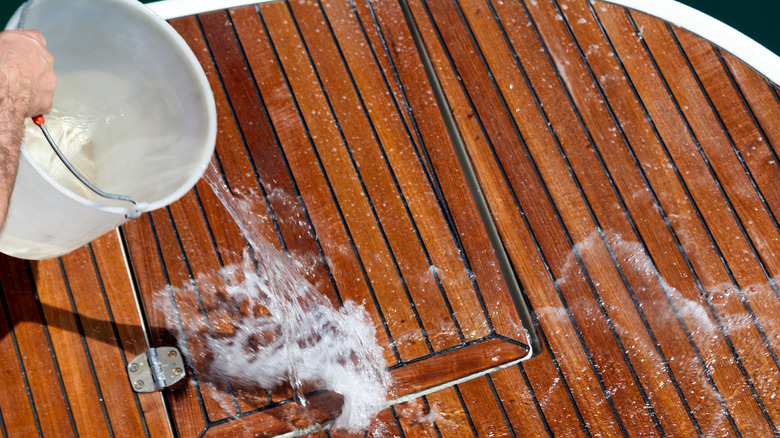Don't Use Chlorine Bleach To Clean Your Wooden Deck. Use This Instead
Cleaning your deck is an integral part of its upkeep and aesthetic. Choosing the right cleaning solution is also crucial for the longevity of your deck and the safety of those who enjoy hanging out there. Some people advise using chlorine bleach as part of a deck cleaning ritual, and this may be tempting since bleach is a thorough disinfectant and cleaner that removes bacteria, mold, dirt, and other stains. But chlorine is also highly corrosive and can damage the surface of the wood over time. Wood is porous and bleach can penetrate deeply, weakening and degrading it.
As a result, you may notice discoloration, warping, or splintering — all signs that your deck may be suffering. Using a more gentle solution like vinegar and baking soda is a great way to help preserve your wood deck's natural look and finish without worrying about damaging its structure. It's one of the deck cleaning tricks you should be using yourself. If you use bleach, your deck may experience cracking or rotting and require repairs or a complete replacement, costing you valuable money that you could otherwise invest in entertaining on the beautiful wooden deck that you've maintained with a simpler and gentler cleaner like baking soda and vinegar.
Why you should use vinegar and baking soda instead of bleach
When you're ready to bid farewell to bleach and turn to a less abrasive solution, choose vinegar and baking soda for a homemade cleaner that will keep your deck looking brand new. Combining these two ingredients will yield great results as each functions independently to fight tough stains and kill microorganisms, but harnessing their powers together will restore shine to your deck without hurting the surface. Vinegar is a versatile cleaning tool and natural acid that cuts through dirt, grease, grime, and mildew. It is potent yet gentle on wood surfaces, breaking down stains without compromising the integrity of the structure of your deck. As long as you dilute vinegar in water and use it to clean sealed or finished deck surfaces, you won't have to worry about damage like you would by using chlorine bleach.
Though vinegar is effective on its own, pairing it with baking soda will help to scrub away stubborn stains and odors as it behaves like a gentle abrasive. Since vinegar is an acid and baking soda is a base, applying both to the surface of a wood deck allows them to tackle and clean dirt and grime with a non-toxic and eco-friendly approach. The two together create a chemical reaction, releasing carbon dioxide gas, which helps to loosen and lift the typical environmental stains lurking on high-traffic decks.
How to clean your deck with baking soda and vinegar
Cleaning a wood deck with vinegar and baking soda is a relatively simple process that won't break the bank or your back. You'll need to gather white vinegar, baking soda, a bucket, a scrub brush with a long handle, and some water to get started. Before you begin cleaning, removing any furniture, grills, or large debris from the surface is a good idea. Give it a good sweep and then wetten it to get started, which will allow the vinegar and baking soda to more effectively tackle dirt and grime. Then combine ¼ cup of white vinegar, ¼ cup of baking soda, and a gallon of water in the bucket. Stir to combine, and allow the fizzing to subside before starting. Alternatively, you can sprinkle the baking soda over tougher stains on the deck, limiting the chemical reaction to the surface instead of the bucket.
Pour the solution over your deck, starting at the end that is the farthest from the exit point. Allow it to sit for a few minutes, particularly if there are deep stains, to encourage the mixture to loosen them. Then, gently scrub the cleaning solution over the wood grooves using the long scrub brush. Work your way along the deck, scrubbing in the direction of the wood grain. Finally, rinse any cleaning residue with clean water and allow it to dry before replacing furniture.


